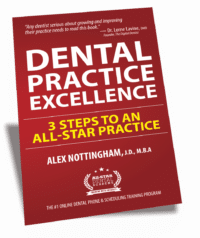Motivational Moments with Eric Vickery: Use “Word Pictures,” like comparing tooth decay to a worm in an apple, to help patients understand conditions and the urgency of treatment for increased case acceptance.
Resources:
About Eric Vickery
Eric holds a degree in business administration and brings a strong business and systems approach to his consulting. His initiation into the field of dentistry was in the area of office management. He managed dental practices for over ten years and has been consulting over 250 offices nationwide since 2001.
Episode Transcript
Transcript performed by A.I. Please excuse the typos.
00:02
This is Dental All-Stars, where we bring you the best in dentistry on marketing, management, and training. Hello friends, welcome to your weekly Motivational Moments with Eric Vickery, president of coaching at All-Star Dental Academy. This week, I wanna talk to you about word pictures, analogies, or telling stories, vivid description of what’s going on. Now, if you remember from the 95-5 rule, we’re focused on conditions and consequences. So, the average
00:32
dental patient has a dental IQ of about a third grade level. Okay, that’s the average person, that’s not you or I. So when we say things like, all right, you have an MODL amalgam with defective margins, let’s do a crown on that tooth. I’m recommending a crown on that tooth. They don’t understand why you’re recommending it. There’s no problem. They don’t have any urgency in that. They don’t feel any pain. I use that saying you’ve heard before, no pain, no problem, no pain.
01:02
So it is really powerful to use a tool that helps them understand what’s going on. So in this example, I would use the Apple. You guys, coaching clients have heard me use this example for years. And so I’ll say to the patient, this tooth here has an old metal filling in it, or there’s a fracture, there’s a gap in between the filling in the tooth, or there’s a hole in the side of the tooth there.
01:31
in any of those situations. You say, it’s like an apple hanging from a tree. If you saw an opening in the side of an apple, like a hole in the side of an apple, Ricky Bobby, what’s going on inside that apple? And he would say, there’s a worm in there. Okay, yeah, and that worm is in there eating the apple. It thinks it’s delicious. Eating the apple, it’s working all the way around that. Now, if that’s just like the decay that’s in there, the opening that’s been created is now allowed decay to get in there and eat all the inside of the tooth.
02:00
the more it eats, the weaker the tooth gets. Now, if that worm were to eat the core of the apple, it would kill the apple quickly. It would die on the branch. And just like with decay, it burrows its way straight towards that nerve of the tooth. Once it exposed that core, the center of your tooth, it creates a situation where the tooth is dying. It’s painful. It’s called an abscess. It’s an infected tooth. And the only way to save that tooth in that situation is with a root canal.
02:30
And I’m sure you’ve heard of a root canal before, am I right? They’ll say yes. What have you heard? Get some feedback from them. Say the analogy I use for that is like if you’ve ever seen an apple core, something that cores an apple, it just takes out that core of the apple. That’s like a root canal, just takes out the nerve of the tooth, the center of it. Most patients don’t wanna go through that, they wanna prevent that process. And so we can do that for you if you understand what’s happening here. If you understand that the sooner you get to this decay, the worm in the apple,
02:59
before it does as much damage as possible, before it turns into a toothache, the better the situation will be. It only costs more money, it only costs more heartache and treatment to go through a toothache with the root canal and then the treatment we’re recommending today. How does that sound to you? Does that make sense to you? How do you feel about that? Use open-ended questions. So what I want you to do this week, every day I want you as a team to start create a library of your…
03:27
your own word pictures, your own analogies that you use, and write them out. Some of you use the apple. Some of you use a cracked windshield. Some of you use the, on gum disease, use the sand on the beach, the house on the beach, and the sand and the washing away and all of that. There’s lots of them out there. What I want you guys to do is every day this week, one or two of you share an analogy that you use, write it down and start to create your working library so that you have verbal skills to go to.
03:56
to help explain the condition of what’s going on. If you notice, this was not about explaining how to do the treatment. This was explaining what’s going on with the tooth and situation to get more buy-in to the problem. So keep in mind, we’re all about our training and events. So alls slash events, go there, see when we’re doing more trainings. We’ll be in Dallas this October, fourth and fifth, doing a level one mastery training on case acceptance.
04:26
We’d love to have you there. So come check it out on the website and then email Heather at alls to learn more information. We’d love to help you get trained and take care of your team and get your patients healthier. Have a wonderful week, guys.
04:41
We hope you enjoyed this episode of Dental All-Stars. Visit us online at allstardentalacademy.com








